Low stress handling of cattle will be easier if you locate and remove distractions that cause livestock to balk and refuse to move
(Updated Decemeber 2021)
Cattle, pigs, and sheep well balk and may refuse to move through a chute, race, or facility if they see distractions such as shadows. If animals to move through an alley, chute or race, there may be a very simple solution.
Once the area is clear of animal traffic, you need to look up the race for common distractions such as:
- Sparkling reflections on puddles
- Reflections on smooth metal
- Chains that jiggle
- Metal clanging or banging
- High pitched noise
- Air hissing - should be silenced with mufflers or piped outside
- Air drafts blowing towards approaching animals
- Clothing hung on the fence
- Piece of plastic that is moving
- Fan blade movement, when the fan is off
- Seeing people moving up ahead
- Small object on the floor - such as a coffee cup
- Changes in flooring and texture
- Drain grate on the floor
- Sudden changes in the color of equipment. Colors with high contrast are the worst
- Race entrance is too dark. Animals will move from a darker place to a brighter place.
- Bright light such as blinding sun. Animals will move from a darker place to a brighter place, but they will not move toward blinding light.
- Animals may balk at one-way and back-up gates. Install them two to three body lengths away from the crowd pen. Equip one-way gates with a remote controlled rope so that they can be held open when the single file race is filled.
Any one of the items on this list may cause animals to stop moving and prevent a properly designed facility from working efficiently. Removal of distractions is most important in facilities where there has been no opportunity to train animals to move through a particular facility.
2021 Update
A new study by Dennis Willson shows the importance of removing distractions. A noisy truck or sharp shadows made cattle more difficult to move.
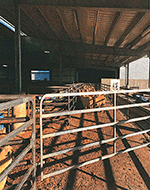 |
Sharp shadows are more likely to cause animals to stop and refuse to move. When sheep left the pens to enter the alley, some of them jumped the shadows. Cattle and pigs are more likely to react by stopping. (Source: Grandin, T. 2021. Frontiers in Animal Science.) |
| Pigs may refuse to walk over this plastic strip on the floor. Animals will move more easily if the same type of flooring is used
throughout a facility. |
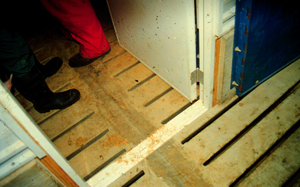 |
 |
You need to get in the chutes and races and see things that the animals see. Animals may balk at the plastic cup on the ground. |
| Animals refused to enter this race because they could see yellow boots moving up ahead. They can see the boots through the grating. |
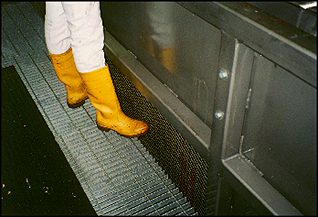 |
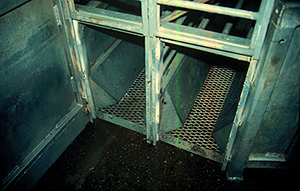 |
The abrupt change in the floor type going from concrete to steel may make pigs balk at the entrance to these races. |
| Animals will not enter this facility because it looks very dark. This picture shows bad design because the wall of the building is located at the junction between the single file chute and the crowd pen. Animal movement into a building can be improved by installing skylights in the roof to illuminate the interior of the building with natural light. Translucent skylights are best because the provide diffuse light with no shadows. |
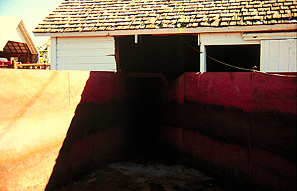 |
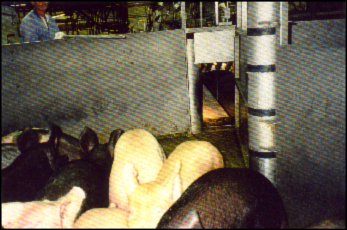 |
Pigs will enter race more easily because it is illuminated with indirect lighting. The animals must not see a bare light bulb. |
| Cattle are attracted towards the open door that lets in light. When the door was closed the cattle balked and refused to enter a dark race entrance. |
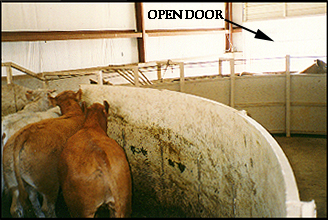 |
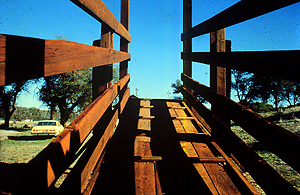 |
This picture shows why it is important to have solid sides on a loading ramp. Animals walking up the ramp may refuse to move because they can see a car. |
| There is a small peice of loose chain hanging down which will make cattle balk and refuse to move through the chute. |
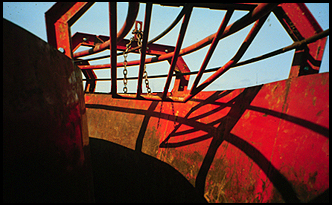 |
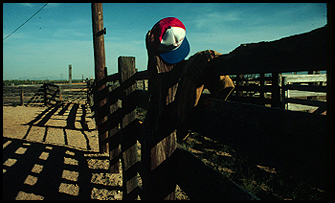 |
A hat or a coat hanging on a fence may make cattle balk. |
| A plywood shield prevents the pigs from seeing people up ahead. Animals will often balk and refuse to approach moving people. Animal movement can often be improved by installing solid panels. |
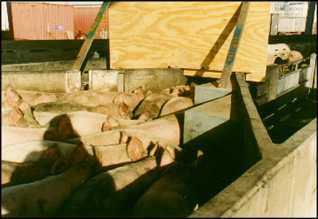 |
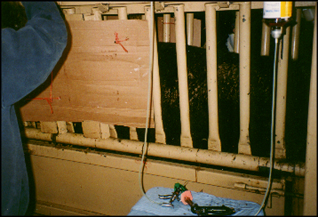 |
Cattle will enter a squeeze chute more easilty if the back half of the open bar sides closest to the tailgate is covered. This prevents an incoming animal from seeing the operator standing by the chute. |
References
Willson, D.W., Baier, F.S., and Grandin, T. 2021. An observational field study on the effects of changes in shadow contrasts and noise on cattle movement in a small abattoir. Meat Science. 179:108539.
 Click here to return to the Homepage for more information on animal behavior, welfare, and care.
Click here to return to the Homepage for more information on animal behavior, welfare, and care.













